Solenoid Valves
Over the years I have tried many different makes and models of valve. Some good, some not so good. My favourite is a noname Chinese clone of the PU220AR. Unfortunately I can no longer buy these but the SLGPC version comes a close second.
Currently the two main types of valve I use are the Shako PU220ARs and SLGPC PU220ARs. I have several other makes which come out occasionally. Like most people doing drop photography I have standardised on valves with a 1/4″ NPT thread. This means the same nozzles can be used on all the valves I have. Using different makes and models together can have benefits but because all the different valves tend to be different sizes it can make alignment more difficult.
Valves with different sized threads (ports) are available and sometimes within the same range, for example the Shako PU220AR which has different models:

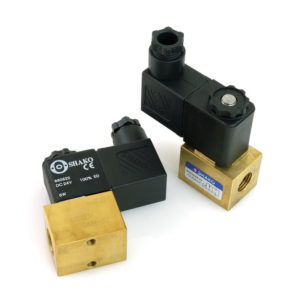 The Shako PU220AR-02. This has become the gold standard for water drop valves. It has reliable and repeatable performance, and can produce relatively small drops (around 7ms to 8ms). Consistent small drops depends and several factors, not just the valve. The liquid and nozzle also play a part.
The Shako PU220AR-02. This has become the gold standard for water drop valves. It has reliable and repeatable performance, and can produce relatively small drops (around 7ms to 8ms). Consistent small drops depends and several factors, not just the valve. The liquid and nozzle also play a part.
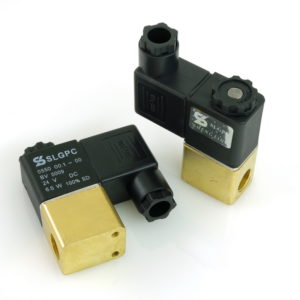 SLGPC PU220AR-02. Similar but not identical to the Shako (smaller valve block but same size orifice), and my current favourite valve. I cannot prove this and my experiments to show it have failed but I feel I get better drops from this valve.
SLGPC PU220AR-02. Similar but not identical to the Shako (smaller valve block but same size orifice), and my current favourite valve. I cannot prove this and my experiments to show it have failed but I feel I get better drops from this valve.
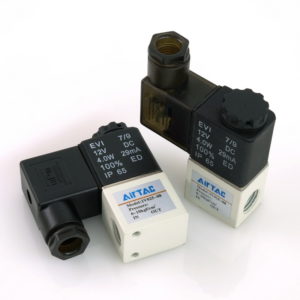 AirTAC 2V025-08. Good performance and fairly cheap. The AirTACs have an aluminium block that needs more TCL than the brass ones and means more frequent and careful cleaning.
AirTAC 2V025-08. Good performance and fairly cheap. The AirTACs have an aluminium block that needs more TCL than the brass ones and means more frequent and careful cleaning.
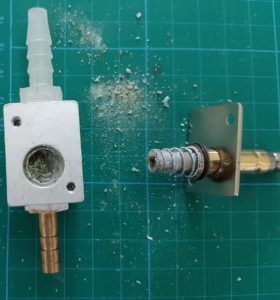 An AirTAC that wasn’t cleaned properly the last time it was used.
An AirTAC that wasn’t cleaned properly the last time it was used.
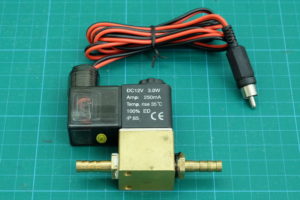 This is still my favourite type of valve, noname Chinese brand that was sold as a Shako clone but it is more like a SLGPC clone (same size). This is an old photo and I now use these valves with 24v coils.
This is still my favourite type of valve, noname Chinese brand that was sold as a Shako clone but it is more like a SLGPC clone (same size). This is an old photo and I now use these valves with 24v coils.
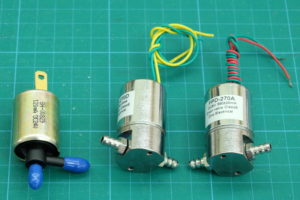 I tried several all in one valves. One was kind of OK but in general I found then too slow.
I tried several all in one valves. One was kind of OK but in general I found then too slow.
There are people using all-in-one valves successfully online but after trying a few I didn’t pursue them.
Honorable Mention
 Chuka 2V025-08, this used to be mentioned online far more than it is now. I haven’t used this valve so cannot comment on the performance but it does appear to be very similar to the AirTAC.
Chuka 2V025-08, this used to be mentioned online far more than it is now. I haven’t used this valve so cannot comment on the performance but it does appear to be very similar to the AirTAC.
 2P025-08, available branded (STC) and unbranded. I believe similar valves are provided with the StopShot system and the Pluto system (same body, different coils).
2P025-08, available branded (STC) and unbranded. I believe similar valves are provided with the StopShot system and the Pluto system (same body, different coils).
EDIT: These are now available with AirTAC coils.
I now have some of these but haven’t had chance to try them yet.
12v or 24v Valves?
The short answer is it doesn’t really matter. The long(er) answer; 24v technically operates faster (very slightly. the difference is so small you will probably not notice.) and uses less current so the power supply can be smaller (lower amperage).
Many many years ago, I started with 12v valves and used only 12v valves for quite a while. I than added some 24v valves and for a while I used both (not at the same time). I then settled on only 24v to simplify things and upgraded the coils on some of the 12v valves to 24v. 24v have a benefit of requiring less current so a smaller power supply can be used. For 12v valves I recommend a minimum of 5amps and for 24v 3amps is ok. However, I still use a 24v 5amp supply so I have extra margin.
Either 12v or 24v valves will work with the dropController just match the voltage of the valve(s) with the voltage of the power supply; 12v valves with a 12v power supply and 24v valves with a 24v power supply. It is not recommended to mix different voltage valves on the same circuit.
If you built your own controller and you want to switch from 12v to 24v you need to check the specs for the mosfets or TIPs you are using to switch the valves. 12v and 24v should be within spec of most mosfets and all TIPs but you never know. Also check the device you are using to drop the voltage to 8/9v to power the Arduino. A DC-DC step down buck converter should have no problems handling 24v but a LM7808 will get hot when used with 24v (and the reason I use buck converters).
Cleaning the valves
The below video shows how to dismantle and clean the Shako valve
Click to display the embedded YouTube video

and this one shows a slightly neglected Airtac 2V025-08 (not as neglected as the one above though).
Click to display the embedded YouTube video

The Airtacs are pretty good valves but they need more maintenance than the brass valves.